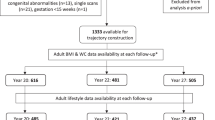Abstract
The fetal origins hypothesis states that nutritional deprivation in utero affects fetal development and contributes to the incidence of diseases associated with the metabolic syndrome in later life. This study investigated whether haemoglobin (Hb) A1c, an indicator of blood glucose, varied among healthy male adolescents according to their fetal growth rate, in a middle-income setting. Participants were men aged 18 years, belonging to the 1982 Pelotas birth cohort. Complete data, including gestational age and Hb A1c at age 18 years, were available for 197 individuals. There was an inverse association between mean Hb A1c and birthweight for the gestational age, but not birthweight alone. The association remained significant after adjustment for family income and mother's education, as well as for body mass index at 18 years (P for trend=0.01 and 0.03, respectively).
This is a preview of subscription content, access via your institution
Access options
Subscribe to this journal
Receive 12 print issues and online access
$259.00 per year
only $21.58 per issue
Buy this article
- Purchase on Springer Link
- Instant access to full article PDF
Prices may be subject to local taxes which are calculated during checkout
Similar content being viewed by others
References
Adair LS, Prentice AM (2004). A critical evaluation of the fetal origins hypothesis and its implications for developing countries. J Nutr 134, 191–193.
Barker D (2003). The developmental origins of adult disease. Eur J Epidemiol 18, 733–736.
Barker D, Eriksson J, Forsen T, Osmond C (2002). Fetal origins of adult disease: strength of effects and biological basis. Int J Epidemio 31, 1235–1239.
Barker D, Gluckman P, Godfrey K, Harding J, Owens J, Robinson J (1993). Fetal nutrition and cardiovascular disease in adult life. Lancet 341, 938–941.
Barker DJP (1994). Mothers, Babies, and Disease in Later Life. BMJ Publishing Group: London.
Barros FC, Victora CG (1999). Increased blood pressure in adolescents who were small for gestational age at birth: a cohort study in Brazil. Int J Epidemiol 28, 676–681.
Barros FC, Victora CG, Horta BL (2001). Ethnicity and infant health in southern Brazil: a birth cohort study. Int J Epidemiol 30, 1001–1008.
Barros FC, Victora CG, Vaughan JP (1990). The Pelotas (Brazil) birth cohort study 1982–1987: strategies for following up 6000 children in a developing country. Paediatr Perinat Epidemiol 4, 205–220.
Bavdekar A, Yajnik CS, Fall CH, Bapat S, Pandit AN, Deshpande V et al. (1999). Insulin resistance syndrome in 8-year-old Indian children. Diabetes 48, 2422–2429.
Eriksson JG, Forsen T, Tuomilehto J, Osmond C, Barker DJP (2001). Early growth and coronary heart disease in later life: longitudinal study. BMJ 322, 949–953.
Hales C, Barker D, Clark P, Cox L, Fall C, Osmond C et al. (1991). Fetal and infant growth and impaired glucose tolerance at age 64. BMJ 303, 1019–1022.
Horta BL (2001). Determinants of catch-up growth in small-for-gestational age infants. Doctoral dissertation, McGill University.
Horta BL, Barros FC, Victora CG, Cole TJ (2003). Early and late growth and blood pressure in adolescence. J Epidemiol Commun Health 57, 226–230.
Kuzawa CW (2004). Modeling fetal adaptation to nutrient restriction: testing the fetal origins hypothesis with a supply–demand model. J Nutr 134, 194–200.
Leon DA, Lithell HO, Vagero D, Koupilova I, Mohsen R, Berglund L et al. (1998). Reduced fetal growth rate and increased risk of death from ischaemic heart disease: cohort study of 15 000 Swedish men and women born 1915–29. BMJ 317, 241–245.
Lima R, Victora CG, Menezes AMB, Barros FC (2005). Respiratory function in adolescence in relation to low birth weight, preterm delivery, and intrauterine growth restriction. Chest 128, 2400–2407.
Victora CG, Barros FC, Lima RC, Behague DP, Goncalves H, Horta BL et al. (2003). The Pelotas birth cohort study, Rio Grande do Sul, Brazil, 1982–2001. Cad Saúde Pública 19, 1241–1256.
WHO Expert Committee on Physical Status (1995): the Use and Interpretation of Anthropometry. Report of a WHO expert committee. WHO technical report series: Geneva, 854.
Yajnik C (2001). The insulin resistance epidemic in India: fetal origins, later lifestyle, or both? Nutr Rev 59, 1–9.
Yajnik CS, Fall C, Vaidya U, Pandit A, Bavdekar A, Bhat D et al. (1995). Fetal growth and glucose and insulin metabolism in four year old Indian children. Diabetic Med 12, 330–336.
Author information
Authors and Affiliations
Corresponding author
Additional information
Guarantor: A Nazmi.
Rights and permissions
About this article
Cite this article
Nazmi, A., Huttly, S., Victora, C. et al. Hb A1c in relation to intrauterine growth among male adolescents in southern Brazil. Eur J Clin Nutr 61, 434–437 (2007). https://doi.org/10.1038/sj.ejcn.1602535
Received:
Revised:
Accepted:
Published:
Issue Date:
DOI: https://doi.org/10.1038/sj.ejcn.1602535
Keywords
This article is cited by
-
Epidemiology of early and late growth in height, leg and trunk length: findings from a birth cohort of Brazilian males
European Journal of Clinical Nutrition (2009)



